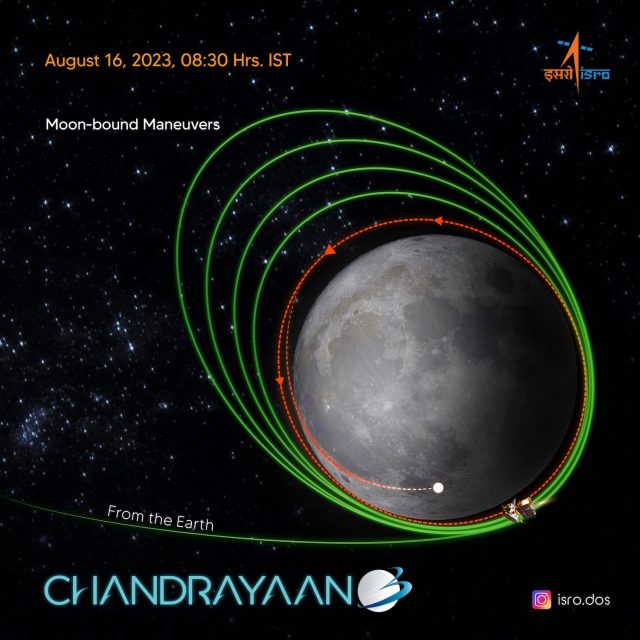
India's Chandrayaan 3 spacecraft is setting up for a final descent to the surface of the Moon on Wednesday, four days after Russia's Luna 25 lander cratered following a botched engine burn.
If all goes according to plan, the Chandrayaan 3 lander—named Vikram—will settle softly onto the lunar surface at 8:34 am EDT (12:34 UTC) Wednesday, redeeming India's failed landing attempt on the Chandrayaan 2 mission in 2019.
But for the last 47 years, reaching the Moon's surface in one piece has proven to be an impossible task for any landing craft that wasn't built in China. Since 2013, China has racked up three successful landings with its robotic space missions, including the first controlled touchdown on the Moon's far side and an ambitious sample return mission in 2020.
Russia's Luna 24 mission returned Moon rocks to Earth with a robotic spacecraft in 1976. Since then, it's been all China. Privately funded landers led by Israeli and Japanese teams failed during their descents to the lunar surface in 2019 and in April of this year, and there was the attempt made by India's Chandrayaan 2 mission four years ago.
All of the US landers that reached the Moon more than 50 years ago have long ago stopped transmitting. Ars has previously reported on the Moon landing missions on tap for the second half of this year. You can cross Luna 25 off that list, and now Chandrayaan 3 is on deck.
Two more US-built landers developed under contract with NASA by two commercial companies—Astrobotic and Intuitive Machines—appear on track for launch before the end of the year, assuming a satisfactory conclusion to final ground tests, and in the case of Astrobotic, the readiness of United Launch Alliance's new Vulcan rocket. A second Intuitive Machines lunar lander, previously set for launch toward the end of this year, has now been delayed into 2024.
Japan is also poised to launch its first lunar lander mission later this week—liftoff is scheduled for Friday night, US time—but that spacecraft won't be in position to touch down on the Moon for about four to six months.
A second chance for India
India's space agency quickly established a follow-up mission to Chandrayaan 2 after its landing failure in 2019. Indian engineers determined the Chandrayaan 2 lander crashed on the Moon due to a cascading series of problems. First, its five braking engines developed higher thrust than anticipated, then the lander's software could not compensate for the error.
India developed the Chandrayaan 3 mission for about $90 million and then launched the spacecraft on July 14. Chandrayaan 3 was launched with a propulsion module to push it out of an initial orbit around Earth toward the Moon, where it arrived in lunar orbit on August 5. Additional engine burns moved the spacecraft into a tighter loop around the Moon, then Chandrayaan 3's Vikram lander separated from its propulsion module last week.
Over the weekend, the Vikram lander maneuvered into an elliptical orbit, taking it as close as 15 miles (25 kilometers) from the lunar surface. The Indian Space Research Organization reported the lander will "undergo internal checks and await the sunrise at the designated landing site." The powered descent is expected to begin around 20 minutes before landing, with Vikram's throttleable hydrazine-fueled engines first pulsing to drop the lander out of orbit.
Then the spacecraft will pitch over from a horizontal to a vertical orientation to start lowering itself toward the landing site, located on the near side of the Moon at about 69 degrees south latitude. A suite of cameras will scan the surface for hazards, providing inputs to the lander's autonomous navigation system to avoid boulders or craters. If the touchdown is successful, Chandrayaan 3's Vikram lander will be the first to explore a site so close to the Moon's south pole, but it won't land far enough south to explore permanently shadowed craters where vast deposits of water ice may be present.

Once on the surface, Chandrayaan 3's Vikram lander extend a ramp to deploy a small rover named Pragyan. The solar-powered mobile robot will "carry out in-situ chemical analysis of the lunar surface," India's space agency said. The lander is designed to function for about 14 days, the length of the lunar day, until sunset at the landing site causes temperatures to plummet to fatal levels.
Vikram's science instruments include a thermophysical experiment to measure the thermal conductivity and temperature at the landing site, a seismic sensor, and a Langmuir probe to measure plasma density. NASA also supplied a laser retroreflector array on the Vikram lander for future lunar ranging measurements.



3175x175(CURRENT).thumb.jpg.b05acc060982b36f5891ba728e6d953c.jpg)

Recommended Comments
There are no comments to display.
Join the conversation
You can post now and register later. If you have an account, sign in now to post with your account.
Note: Your post will require moderator approval before it will be visible.